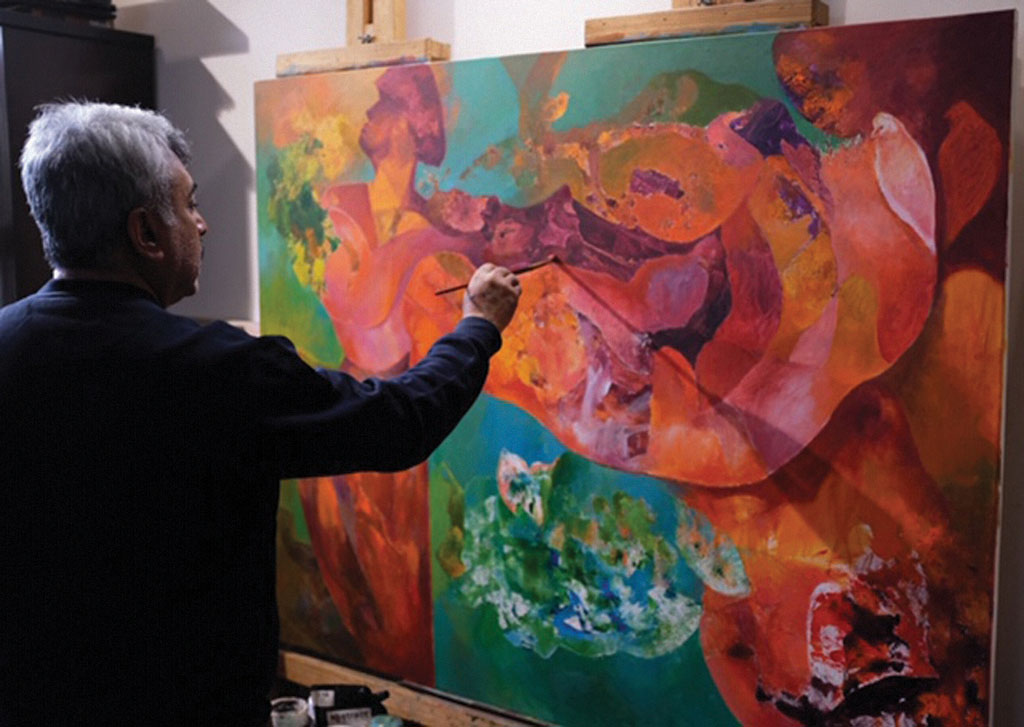Ghulam Rasool Santosh
Ghulam Rasool Santosh was a prominent Indian painter known for his themes inspired by Kashmir Shaivism. He was eminent artist from the movement known as neo-tantra in Indian art. A self taught artist whose life was full of struggle, found solace in mystical experience that changed his theme and style of painting.
His son Shabir Hussain a painter of repute shares fond memories of his father from the core of his heart, enabling us to get closer to the great master-Ghulam Rasool Santosh.

Goldy Malhotra : What are your earliest memories of seeing you father paint?
Shabir Husain : I was four years old and we used to live at Jangpura Extension in Delhi where my father had a small studio. I remember he used to ask us to sit in a corridor as models and he worked on our marvelous portraits. He was very good at portraits and was known for it. It is vivid in my memory.
G. M. : Did he talk about Art to his children? What where the questions in your mind related to themes and his style of paintings?
S. H. : He was an excellent story teller and through them explained his paintings. When I was in high school, he was always keen to talk about his family background and the years spent in Kashmir. I was a good observer and came to know a lot about my father as an artist by listening to his friends M. F. Hussain, Sultan Ali, Aman Nath Sehgal, Pradosh Das Gupta, Ramachandran and many others who were visiting him regularly. Their discussions, sharing of the experiences were part of the parties held at our place.
G. M. : Did he ever bring his anxiety home or talk about his struggle?
S. H. : I could read him as he always had an honest transparent face. Infact all the artists were struggling in the 60s because there were very few galleries in Delhi and hardly any buyers. Bombay was a better Art market and my father also felt the same like most of his friends. Few Brazilian, American and German diplomats were the only buyers through their Embassies. Mr. Chester Herwitz who was dealing in leather business, bought many works of good artists and opened a museum named Herwitz Museum in US:, presently his collection is at Peabody Essex Museum in Salem, Massachusetts. Mr. Hertvitz with his wife Davida maintained a charitable trust to support Indian Art in US. This was a big exposure for Indian Art of that time and also provided an international platform.
G. M. : Was it his desire to see you as another artist in the family or the choice was entirely yours?
S. H. It was my choice. I was a keen sportsman but always had an inclination for art and started painting in his studio and that worked as an emotional security for me. He saw an artist in me, though I was not focused yet he had foreseen and put me on the track.
G. M. : How was his life style reflected in his art?
S. H. He came from a very humble background. His father was serving in the Police department and wanted his son to start working to support the family soon after his matriculation. He was given the job of ‘Ghaat Munshi’ to maintain the distribution of rashan at river Jhelum.
To get rid of his boredom, he kept working on the landscapes that he started painting at an early age. He was totally self-taught and learnt mainly from studying nature. His teachers at school often complained that he reached school very late and infact it was because on his way he used to walk through valleys and brooks to study and admire nature. His father was never happy with his art activities because he used to spend the money on paints and materials. Gradually he started selling his landscapes to tourists and brought some earnings home to please his father.
G. M. : What was the best lesson on Art that he passed on to you directly or indirectly?
S. H. I went to college of Art for my formal education but I had another institution to learn from – my father’s studio at home at Bharti Artist Colony. He had a studio at Garhi and his studio at home was used by me. In the evening he used to take full account of my day’s labour on the canvas. At times very encouraging and at times very frustrating due to his bluntly honest negative remarks. Now I realise, that was being a true teacher who did not believe in showering compliments only. In calmer moments he used to rectify my piece of art and teach me as a hand-holder. Colour application was the main form of art that he taught me.
G. M. : A very personal question- your parent’s love story is known to all. Did he ever talk about what made him use your mother’s name in place of his sirname?
S. H. Yes, sometimes he used to talk about it. He was a romantic poet and went to Amarnath in 1964 where his perception about himself completely changed. Being a Kashmiri the Shavism started surfacing and he became spiritual and mysticial. Under the influence of Lal Ded, he started composing spiritual verses that was blend of Shaivism and Vaakh. For a brief time, he became a scholar and did not paint at all. At this time, he changed his name to G. R. Santosh. Santosh being my mother’s name. Went back to painting and this was the beginning of Tantric phase, that he is known for.
G. M. : In your moments of solitude, do you evaluate your achievements that you could share with your father?
S. H. Yes, but I miss him a lot because my training under him was left incomplete due to his untimely demise. Today I am known as a colorist and I share this with him in my solitude, though still working to reach where he would have wanted me.
G. M. : How is Shabir the artist different from the great master G. R. Santosh?
S. H. He was self-taught, life, mysticism and mother nature were his teachers. I am influenced by him in usage of colour. Being a disciplinarian, he wanted me to be trained and was happy to see me develop my own style. He was an introvert and I am an extrovert. He was very simple and down to earth, extremely humble without any ego or inhibition. I am enjoying the comforts provided by him.
G. M. : What would you like the present generation to learn from G. R. Santosh’s life?
S. H. Do not follow the west. Cling to your roots. East has always been the leader in art, architecture and sculpture. By copying the west, we can lose our track. We always stylized abstraction unlike the western realistic art.
G. M. : Lastly, one word to explain G. R. Santosh.
S H. He was an institution in himself. A polymath who excelled at every thing.

